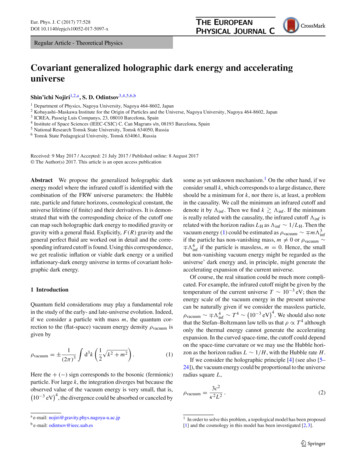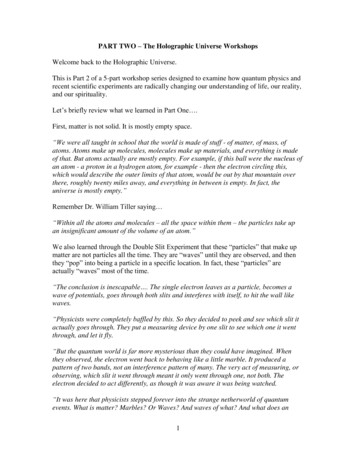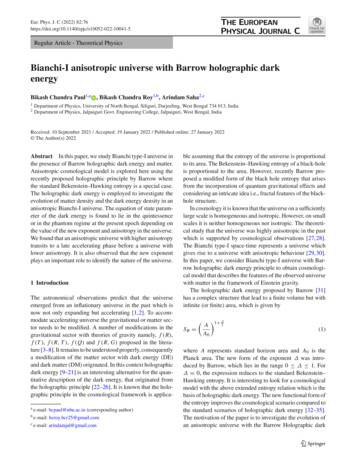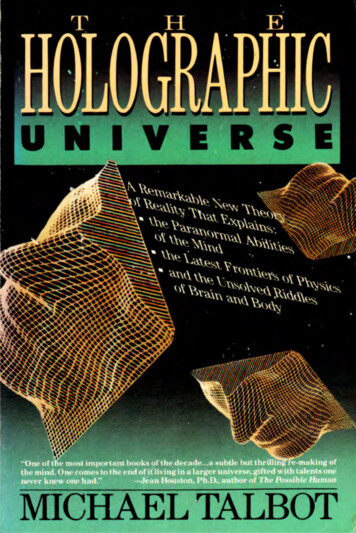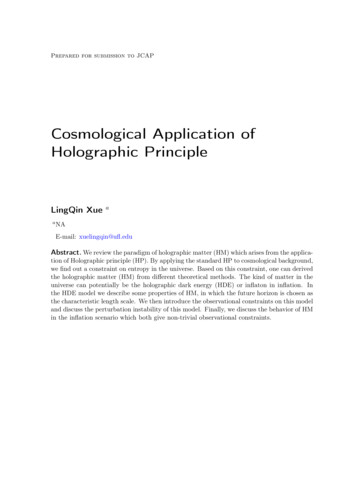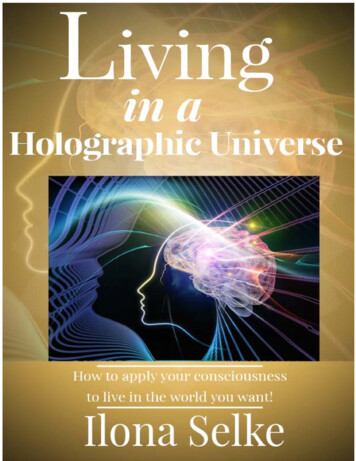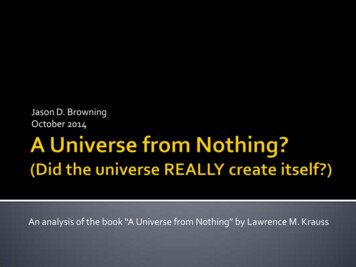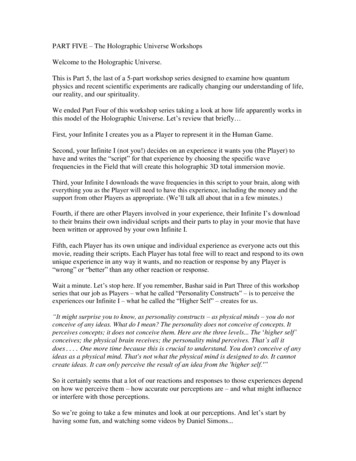
Transcription
PART FIVE – The Holographic Universe WorkshopsWelcome to the Holographic Universe.This is Part 5, the last of a 5-part workshop series designed to examine how quantumphysics and recent scientific experiments are radically changing our understanding of life,our reality, and our spirituality.We ended Part Four of this workshop series taking a look at how life apparently works inthis model of the Holographic Universe. Let‟s review that briefly First, your Infinite I creates you as a Player to represent it in the Human Game.Second, your Infinite I (not you!) decides on an experience it wants you (the Player) tohave and writes the “script” for that experience by choosing the specific wavefrequencies in the Field that will create this holographic 3D total immersion movie.Third, your Infinite I downloads the wave frequencies in this script to your brain, along witheverything you as the Player will need to have this experience, including the money and thesupport from other Players as appropriate. (We‟ll talk all about that in a few minutes.)Fourth, if there are other Players involved in your experience, their Infinite I‟s downloadto their brains their own individual scripts and their parts to play in your movie that havebeen written or approved by your own Infinite I.Fifth, each Player has its own unique and individual experience as everyone acts out thismovie, reading their scripts. Each Player has total free will to react and respond to its ownunique experience in any way it wants, and no reaction or response by any Player is“wrong” or “better” than any other reaction or response.Wait a minute. Let‟s stop here. If you remember, Bashar said in Part Three of this workshopseries that our job as Players – what he called “Personality Constructs” – is to perceive theexperiences our Infinite I – what he called the “Higher Self” – creates for us.“It might surprise you to know, as personality constructs – as physical minds – you do notconceive of any ideas. What do I mean? The personality does not conceive of concepts. Itperceives concepts; it does not conceive them. Here are the three levels. The „higher self‟conceives; the physical brain receives; the personality mind perceives. That‟s all itdoes. One more time because this is crucial to understand. You don't conceive of anyideas as a physical mind. That's not what the physical mind is designed to do. It cannotcreate ideas. It can only perceive the result of an idea from the 'higher self.'”So it certainly seems that a lot of our reactions and responses to those experiences dependon how we perceive them – how accurate our perceptions are – and what might influenceor interfere with those perceptions.So we‟re going to take a few minutes and look at our perceptions. And let‟s start byhaving some fun, and watching some videos by Daniel Simons.
“I‟d like you to take a look around you. Take a look at all the sights, the sounds, if you‟reunlucky, the smells. You feel like you‟re seeing the world in all its completeness anddetail. You feel like you‟re experiencing the world as it is. But that experience, as it turnsout, is an illusion. What you actually experience is what your mind and your brain giveyou. It‟s an alternate reality.“Take a look at this image, by Julian Beaver, who‟s a British artist. Now, this is anillusion. This is a nice painting of a swimming pool. It looks like it has depth. It looks likethere‟s a woman sitting in the pool. It looks like Julian Beaver in the upper right isdipping his foot into the pool. And as he‟s doing this, you feel like you‟re seeing theworld as it is. But of course, it‟s not. It‟s chalk art on a sidewalk. It just gives theimpression of depth.“And this is a double illusion, because as you‟re looking at this, you feel like, “Okay.Yeh, I‟m seeing a painting of chalk art on a sidewalk. But what you‟re actually seeing isa really weird view of a chalk painting on a sidewalk – you‟re seeing a chalk painting ona sidewalk from the one view that gives you the impression of depth – that gives you theimpression that you‟re looking at a swimming pool – and from any other perspective, itlooks much more like this. It‟s really substantially distorted. The key is that we feel we‟reseeing it as it is, but we‟re actually not.“Let me give you another example. This is from my colleague Bart Anderson. What yousee here are two sets of chess pieces. The ones on the top look dark, the ones on thebottom look light. I‟m sorry .the ones on the top look light, the ones on the bottom lookdark. And you can‟t help but see them that way even though that‟s not at all what you‟reactually seeing. Here‟s what you‟re actually seeing – I‟m just removing the background.and when I remove the background you can see that both sets of pieces are the same kindof mottled gray, and every piece on the top is exactly the same as the one directly belowit.“Now that you know that, of course, you‟ll be able to see them as they are when I showyou the same image again, right? Nope. Once you go back to the background, you can‟thelp but see it as it isn‟t. Your visual system is giving you the impression that you‟reseeing light pieces and dark pieces, when you‟re actually seeing the same thing in bothcases. What‟s happening here is that your visual system is taking into account not just thebrightness of those individual pieces, but the brightness of the surfaces immediatelyaround those pieces.“And it takes that into account in a way that is actually really useful for us most of the time.It gives us the ability to see a piece of paper with black ink on it the same inside in a darkroom and outside in a really bright light. But it‟s not giving us the world exactly as it is. It‟susing a bag of tricks. It‟s using a set of shortcuts to give us the world as we need it.“Now, what makes visual illusions like this so cool? There are two reasons. One is that it‟ssurprising. But that‟s not terribly satisfying. The more interesting reason is that it‟s giving usthe impression that we‟re seeing the world as it is, and it‟s violating that impression. It‟sbreaking our intuition. It‟s forcing us to confront the fact that we aren‟t seeing the world as itactually is.
“Let me give you another example of this. This is from Bill Geisler and Jeffery Perry.This is a nice picture of flowers, pleasant for today. I‟m going to show you a bee, and Iwant you to follow that bee around this image with your eyes. So track the bee as itmoves through the image. It‟s just going to kind of wander around the image here. You‟reable to follow it just fine. And eventually it‟s going to end up back where it started. Andwe‟re back.“Okay. Now I want to show you exactly the same sequence, except that this time, insteadof tracking that bee with your eyes, I want you to maintain your focus, maintain yourgaze right on the bright yellow flower. And notice what happens to that flower as the beegets farther and farther away. It gets blurrier and blurrier.“It‟s exactly the same sequence. You‟re seeing exactly the same thing you did the firsttime, except that this time you probably noticed the flower getting blurry, whereas thefirst time you didn‟t notice that anything was changing about the image at all. Now whyis that?“The reason is that you‟re actually only taking in detail from a tiny, tiny subset of yourvisual world at any instant. In fact, you‟re taking in detail from a subset about the size ofthat bee. If you stick your arm out and put your thumb up, you‟re taking in highresolution information only from the information about the width of your thumb. Beyondthat it becomes progressively blurrier. But we don‟t notice this at all. Why not?“Well, we move our eyes three or four times a second when we‟re looking at the world –we don‟t realize we‟re doing that; and everywhere we look at that instant, we‟re seeingeverything in detail. If something is in our periphery and it‟s potentially interesting, welook over there and see it in detail. So we get the impression – the false impression – thatwe‟re seeing everything in detail.“Let‟s take a look at this issue. We assume that everyone is seeing the world exactly as itis, and this has profound implications for how we think about the world around us.Despite differences in our knowledge and our beliefs and our expectations, we feel likewe‟re seeing the same thing as everybody else. I use visual illusions as a way ofillustrating how we don‟t see the world exactly as it is.“But these sorts of illusions are not just limited to our visual system. They also affect theway we think, the way we remember, the way we reason. We think we see more than wedo. We think we see all of the detail around us – we don‟t. But we also think weremember more than we do, and that we know more than we do. And these illusions leadto a really substantial problem – they lead us to think that everybody is seeing the samething we are, when in reality, two people looking at exactly the same world can be takingin different information at the same time.“Now what does that mean? It means that any time you have to communicate – any timeyou‟re trying to be a trainer, or a CEO, or a leader, or you‟re trying to lecture or teach –you have to take into account the fact that your knowledge and your experiences andwhat you see are going to be different from those of the people in your audience. All ofadvertising depends on exactly that principle. You have to know what your audience isgoing to see in the advertisement.
“Now, the problem is that, even though we don‟t all necessarily see the world the same, weall share one thing – this illusion that we see the world the same as everybody else. And onlyby testing your knowledge, and testing what you‟re actually seeing – just like you do witha visual illusion – do you realize that you‟re not actually seeing the world as everybodyelse is. And in fact we don‟t all see the same thing. Only by testing your knowledge canyou see the world as it actually is.”Here are some important quotes from that video.“The key is that we feel we are seeing [the world] as it is, but we‟re actually not. [Ourperception] is not giving us the world exactly as it is. It‟s using a bag of tricks; it‟s usinga set of shortcuts to give us the world as we need it.”“We assume that everyone is seeing the world exactly as it is, and this has profoundimplications for how we think about the world around us. Despite differences in ourknowledge and our beliefs and expectations, we feel like we‟re seeing the same thing aseverybody else, and in fact we don‟t all see the same thing.”“Now the problem is, even though we don‟t necessarily see the world the same, we all shareone thing – we share this illusion that we see the world the same as everybody else.”“I use visual illusions as a way of illustrating that we don‟t see the world exactly as it is.Only by testing your knowledge, and testing what you‟re actually seeing, do you realizethat you‟re not actually seeing the world as everybody else is.”So let‟s take Dr. Simons‟ suggestion and test our perceptions to see how accurate theyreally are.Some of you may have seen these before. If so, just play along.Grab a piece of paper and something to write with, and number down the lefthand sidefrom 1 to 13. Now simply answer the questions starting with #1 .Number 1. True or False: The red lines are all straight and parallel.Number 2. True or False: The green column is the largest of the three columns.Number 3. What color is the line making the circumference of the circle?Number 4. True or False: The red lines are all straight and parallel.Number 5. How many different colors do you see in this picture?Number 6. Which dot in the middle is bigger (A or B)?Number 7. True or False: Every line in this picture is straight and parallel.Number 8. True or False: Line A-B is longer than line B-C.
Number 9. Which box has the darkest grey dot in the middle (1, 2, 3, 4, or 5)?Number 10. True or False: The long straight lines are all parallel.Number 11. True or False: The straight vertical line in A is longer than the straightvertical line in B.Number 12. Do you see a young woman or an old hag?Number 13. Are you looking at the front or the back of this woman?Let‟s see how well you did . how good your perceptions are .Number 1 is True. The red lines are all straight and parallel.Number 2 is False. All three columns are the same size.The answer to Number 3 is that there is no line making the circumference of the circle. Itjust appears that way.Number 4 is True. The red lines in the pictures are all straight and parallel.In Number 5, there are 3 different colors – white, red, and green The red is the samered throughout the picture, and the green is the same green throughout the picture.In Number 6, both the dots in the middle of A and B are the same size.Number 7 is True. Every line in the picture is straight and parallel.Number 8 is False. The line from A to B is exactly the same length as the line from B toC.In Number 9, all the grey dots in the middle are exactly the same shade of grey.Number 10 is True. The long straight lines are all parallel.Number 11 is False. Both straight vertical lines in A and B are exactly the same length.Number 12 is interesting, because both a young woman and an old hag are there. Can yousee both?Looking at the left side of the old hag‟s face, you can see her left eye, her nose, and herchin. Looking at the left side of the young girl‟s face from behind, you can see the tip ofher nose, her left ear, and her chin.Number 13 is equally as interesting. You can see this woman from the front, or the back.The best way is to look at her breast. If you see this woman from behind, that‟s her right
breast, and her left knee is in front. If you see her from the front, that‟s her left breast, andher right knee is in front.If you have seen these illusions before and know the correct answers – or if you couldfigure them out – you still have to force your mind to overrule your brain, because,honestly, when you look at these illusions, our brain perceives them to be very differentthan what they actually are.This whole question of perception is a fascinating topic, and apparently very key to ourjob as a Player. So we‟re going to watch two more videos with Dan Simons, who is aprominent experimental psychologist, cognitive scientist, and Professor in theDepartment of Psychology and the Beckman Institute at the University of Illinois.Simons is most well known for his work on change blindness and inattentional blindness,two surprising examples of how people can be unaware of information right in front oftheir eyes.This next video is his most famous, and will test what you‟re actually seeing.“The Monkey Business Illusion. Count how many times the players wearing white passthe ball. The correct answer is 16 passes. Did you spot the gorilla? For people whohaven‟t seen or heard about a video like this before, about half miss the gorilla. If youknew about the gorilla, you probably saw it. But did you notice the curtain changingcolor or the player on the black team leaving the game? Let‟s rewind and watch it again.Here comes the gorilla, and there goes a player, and the curtain is changing from red togold. When you‟re looking for a gorilla, you often miss other unexpected events. Andthat‟s the monkey business illusion.”Now watch Dr. Simons as he talks about this invisible gorilla video.“I‟m Dan Simons. I‟m a professor in the psychology department at the University ofIllinois, and I also have an appointment at the Beckman Institute for Advanced Scienceand Technology. My research here focuses on visual cognition – what we see, what wedon‟t see, how much of our visual world we‟re aware of, how much we remember fromone moment to the next.“One of my best-known studies was done with my collaborator, Chris Chabris, someyears ago, and it was based on some much earlier work by our colleague, Dick Neiser.What we had was a video in which people were passing basketballs. So three people werewearing white shirts, and they were passing a ball, and your task when you werewatching the video was just to count how many times those three players passed the ball.We also had three players wearing black shirts passing their own ball, and you weresupposed to ignore their passes.“So as you‟re doing this task – after about 30 seconds, say – we‟d have a person wearinga full-body gorilla suit walk into the middle of the scene, stop in the center, turn and facethe camera, thump its chest, and then walk off the other side – a total of about 9 secondslater. And what we find is that about half of the people who do this simply don‟t noticethe gorilla.
“When Dan asked me to be a part of this experiment, I thought, “No way! People aretotally going to see me. I‟m a 400-pound gorilla.“We‟ll ask them afterwards, “How many passes did you count?”, which they generallyget pretty close to right. We then ask them, “Did you notice anything unusual?” “Didyou notice anything other than the players?” “Did you notice anything walk through thescene?” And they‟ll say, “No.” So we‟ll ask them, “Did you notice a gorilla?” And theresponse is typically, “A what?”“Then this Simons guy says, “You know, we can show you, but not everyone‟s going tosee you.” Yeah, right. How can people not see me? I‟m huge. I‟m ferocious. I‟m a 400pound gorilla. What was he thinking?“We‟ll rewind the tape and show it to them again, and the reaction is typically, “I missedTHAT!” It‟s shocking that you could possibly miss something as obvious as a gorilla. Ofcourse, the people who noticed the gorilla are shocked that anybody could possibly havemissed it, because it‟s right there in front of you.“I walk in there. I walk in the middle. All these kids are running around throwing thisball around. I stand there. I thump my chest – not once, not twice. three times I thumpmy chest. That‟s scary, man. What else are people going to look at? You know, I‟m big.I‟m a gorilla. And they don‟t see me. What‟s up with that?“This is the intuition we have, that if something important or distinctive or unusual – likea person in a gorilla suit – walks into our field of view, we‟ll automatically notice it. Thereality is that only about half the people do. About 90% think they will.“People are just so focused on counting those passes that they don‟t notice me. Youknow, I‟m not trying to be subtle here.“Even more remarkable, my colleague Daniel Memmert used the gorilla video in a studyin which he had people wearing an eye-tracker. What that does is tells you exactly wherethey‟re looking as they‟re watching this video and counting the passes by the teamwearing white. And what he found was that the people who missed the gorilla looked at itfor up to a second. So they looked right at it but still didn‟t see it. Looking isn‟t the sameas seeing. We have to focus attention on something in order to become aware of it.“How do you think it makes me feel? You know, I‟m trying to be intimidating. It makesme feel. inadequate.“The most consistent question we get is, “Are there some people who consistently noticethe gorilla, and other people who don‟t?” So, are there “noticers” and “missers” amongus? And the reality seems to be “No,” that it‟s largely just a matter of a flip of the coin.We know when we‟ve noticed something unexpected, but we‟re not aware of the timeswhen we‟ve missed something unexpected. The failure to notice people in gorilla suits isreally a natural by-product of something that we do quite well, and that‟s very importantto us, which is focusing our attention. We need to be able to filter out the distractionsfrom our world and not let them interfere with our ability to do the task we‟re trying to
do. The key is that when you‟re focusing your attention on one aspect of your world, youdon‟t have an unlimited amount of attention to devote to other things. And we only seethose things that we focus our attention on.“The problem is that on occasion we filter something that we might want to notice, andwe don‟t realize that we‟re doing that. That sort of mismatch between what we see andwhat we think we see is a really profound one that has all sorts of consequences for ourdaily lives.“Okay, I admit it. I didn‟t see me either.”Dr. Simons said that “We only see those things that we focus our attention on,” and “thatsort of mis-match between what we see and what we think we see is a really profoundone that has all sorts of consequences for our daily lives.”But this doesn‟t apply only to gorillas, obviously. If we, as Players, are focused on whatwe don‟t have in life that we think we want or need, we could easily not see or fullyenjoy and appreciate all the things we DO have.If we focus on the fear of losing our wallet from our pocket as the rollercoaster goesupside down, we could miss all the fun (?) and excitement of the ride.If we focus on trying to “visualize” and “manifest” and “attract” what we think we wantin a mate, we could miss the one right in front of us who could actually be “the one.”If we focus on trying to avoid the dangers of taking risks, we could miss the mostexciting opportunities of our lives.If we focus on our fear of dying, we could miss living. You get the point.Dan Simons is a lot of fun, but I want to get back to the question, which is If our job as Players is to perceive the experiences our Infinite I creates for us and if wedon‟t seem to be doing a very good job of that, according to Dan Simons are thereother factors involved – more than just our focus – that are influencing and affecting ourperceptions making us see the world “as we need it,” rather than as it actually is?It‟s time to introduce you to Dr. Bruce Lipton .Dr. Lipton began his scientific career as a cell biologist. He received his Ph.D. from theUniversity of Virginia in Charlottesville, Virginia, before joining the Department ofAnatomy at the University of Wisconsin‟s School of Medicine in 1973.In 1982, Dr. Lipton began examining the principles of quantum physics and how theymight be integrated into his understanding of the cell‟s information processing systems.In the process he discovered that the brain of a cell is not in the nucleus, which is what Iwas taught in school, but in the membrane – the outer surface, or “skin” of the cell.
His website says “His research at Stanford University‟s School of Medicine, between1987 and 1992, revealed that the environment, operating through the membrane,controlled the behavior and physiology of the cell .“His discoveries, which ran counter to the established scientific view that life iscontrolled by the genes, gave rise to one of today‟s most important fields of study, thescience of epigenetics. Many subsequent papers by other researchers have since validatedhis concepts and ideas.”Epigenetics is to biology what quantum physics is to physics; it has turned our age-oldunderstanding of biology upside down; or, as I‟ve put it many times already, the oppositeof what we have always believed is true. For example, from epigenetics we now knowour perception of the environment controls our DNA, and not the other way around.We‟re going to watch three video clips from Dr. Lipton, whom I am honored to say is myfriend. In this first video, he‟s also going to give you a short perception test, so watchcarefully.So, there are three conclusions. I don‟t have enough time to talk about one, but I will listthem. Conclusion 1: Perception – how you see life, “the switch” – controls behavior,because that‟s protein. Perception controls which genes are being read and how they‟rebeing read. And the one I didn‟t have time for right now is the third one: perception can rewrite the genetic code. So perception controls life. No two people see the world in the sameway. They have different perceptions. But let‟s do a perception test.“Is the surface area of A greater than, equal to, or less than the surface area of B? Whichis greater? B. Yeh. They‟re equal size squares. Not equal, but they‟re uniform.“So I want to make a more difficult test. I will show you two surface areas that are notregular. You must, with your mind, see which is bigger. Which has more surface area.Europe or South America? The answer is. South America. South America is 2 timeslarger than Europe. Twice as large. you could see that, right? Ah. the map is wrong.This is the Mercator map. It was made by Germans. Where did they put Germany?Deutchsland is in the dead center. Isn‟t the equator the dead center? This map is wrong.You want to see the correct map? It called the Peters Projection map. Which is larger.South America or Europe?“The point is that you learn perceptions, and sometimes your perceptions can be right,and sometimes your perceptions can be wrong. Since perception controls biology, andsince they can be right or wrong, then it‟s more accurate to say that belief controlsbiology. What you believe creates your life, on the inside and on the outside.”If there was one thought I would pick out of that video to remember, it‟s this.“Perception controls life. Sometimes your perceptions can be right, and sometimes yourperceptions can be wrong. and since perceptions can be wrong, it is more accurate tosay that beliefs control biology – what you believe creates your life, on the inside and onthe outside.”
One example Dr. Lipton uses is what‟s called the “placebo effect.”“Placebo” is normally used as a medical term, meaning a patient is given somethingneutral – like a sugar pill – and yet it makes them feel better. There is no chemical reasonin the placebo for it to have any effect at all on the body, but it does somehow. That“somehow” is because the patient believes it will, and nothing else. It is the patient‟sbelief that changes their biology and their behavior.But this “placebo effect” does not have to be limited to medicine or pills. In fact, it is inoperation a lot of the time as we, the Players, believe something – anything – is good forus that is actually neutral, and yet it makes us feel better.This, of course, is true for all homeopathic remedies as well. Homeopathy is still basedon a belief that taking something from “out there” – “natural” though it might be – willhave an effect “in here.”The other side of the coin, and not nearly as well known, is the “nocebo effect.” This iswhen a patient – or a Player – believes something, anything, that is actually neutral isharmful to them; and it makes them feel bad or worse, when in fact there‟s nothing in thenocebo that can hurt them at all.Take a look.“Now we have heard of something called the “placebo effect,” right? The “placeboeffect” is when you have a very positive thought that something can heal you. You don‟tknow it‟s a sugar pill, but if you believe it‟s the real medicine, then you can heal yourselfwith that. So the pill didn‟t heal you; it was the thought that healed you. Statistics revealthat one-third of all medical healings, including surgery, are the result of the “placeboeffect.”“Now, the placebo effect is when you have positive thinking. There was a question thismorning: What about negative thinking? This is what medicine does not tell you – thatthere is negative thinking, and it‟s called the “nocebo effect.” And in the same power thatpositive thinking can heal you, negative thinking can kill you. They‟re both the sameeffect – one is more positive, one is more negative – but the effects are exactly the sameon your health. One will heal you, and the other can make you sick.“If a doctor tells you you have a disease, or the doctor tells you you‟re going to die, andyou believe the doctor because he‟s a professional, the belief will give you a disease andcan cause you to die. So belief becomes an important part of medicine.“Many of you have heard about the drug, Prozac. Every year billions of dollars are spenton buying Prosac. And here‟s a surprise – the Prozac is no better than a sugar pill, sothat it is a placebo drug. Yet the people who take it believe in the drug so much, it makesthem better.“So if you believe that something is good for you, it will be good, and if you believe thatit‟s harmful for you, it will be bad.
“In the United States, in the south, there‟s a religious group called the BaptistFundamentalists. This group works themselves up into a state of religious ecstasy, andthey believe God protects them. So they will work with poisonous snakes, likerattlesnakes, and they will even get bitten by the snake, and nothing happens to them.Some of them will drink Strychnine in toxic doses, and when they‟re in that state of belief,it does not affect them.“So if you can drink toxic poison, then why do we worry so much about the toxins in thefood, and in the air, and all that? Because we have a belief that the toxins can kill us. Andeven on the cigarette package, it tells you: This will kill you. But even though I know this,I will not drink Strychnine, because my belief is not as strong as their belief.“Belief is important about everything, including our health, and our aging, and the worldthat we live in. This is a picture of some beautiful women who dance in the Palm SpringsFollies. And I ask, what do you think is unusual about these women? They have arms, butthey‟re in red gloves against a red [background], so it‟s hard to see. What is unusual?Their ages. 75 years old. Aging is not in their belief, because they have a passion todance, and the passion keeps them young, and alive, and healthy. But most of us see otherpeople grow old and expect that we must grow old like they do.”In both cases – the placebo and the nocebo – it is the Player‟s belief and not the actualexperience that controls their perceptions and determines their behavior.Dr. Lipton said, “If you believe that something will be good for you, it will be good; andif you believe that something is harmful, it will be bad.”He also said, “If you can drink toxic poison, then why do we worry so much about thetoxins in the food and the
frequencies in the Field that will create this holographic 3D total immersion movie. Third, your Infinite I downloads the wave frequencies in this script to your brain, along with everything you as the Player will need to have this experience, including the money and the support from other Players as appropriate.


